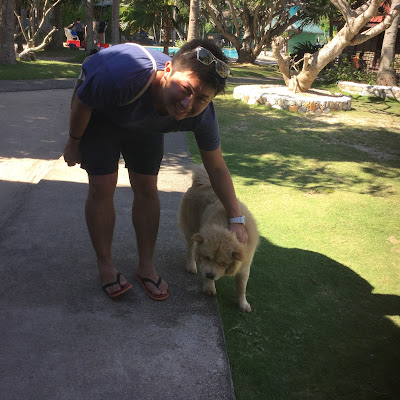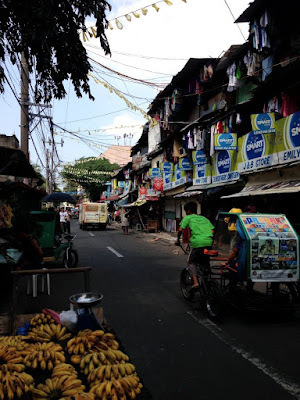It's funny- before I embarked for Macedonia, even before I
knew what my Peace Corps experience would entail, I had planned an element of
my Close of Service (COS) trip. My trip
would end in the Philippines, where I would join my family for a set of
reunions. Many of these reunions would
occur in January, and they would commemorate wedding anniversaries, my late
grandmother's 100th birthday, and a reunion of my large extended family (I have
20+ cousins on my father's side). However,
with my 6 month extension, the tail end of my COS trip instead became just
another international trip during my service.
This was the second time that I had visited the Philippines,
as I first visited the country during the summer of 2001. Before I departed Macedonia, I was sick with
a cold, and since my dinky heater is not capable of heating my whole apartment,
I looked forward to being in a place where I was not constantly shivering. Besides the excitement of seeing my family
for the first time in about a year, I also anticipated seeing my good friend, Ted, who would arrive
in Manila from Japan on the same night as me.
A Bit of a History Lesson
Last year, when I announced my plan to visit the Philippines
to one of the Peace Corps doctors, she responded that of all the countries in
the world, the Philippines reminds her the most of Macedonia. Her reasoning: both countries were conquered
by various empires through their histories and were between major transit zones
in their regions, and thus the people of each country are conditioned
accordingly. In many ways, I agree with
her statement, and I found the similarity between the Macedonian and Filipino
concept of hospitality striking.
According to http://www.philippine-history.org,
the Philippines was first subjugated by the Borneo sultanate. Arab Muslims arrived in the southern parts of
the Philippines around 1380, and the Muslim Malays loosely ruled the
Philippines until Magellan first discovered the archipelago for Europe in
1521. Spain continued to send
expeditions to the Philippines (Philippines was named after the Spanish king,
Philip II), and they ruled the islands for about 350 years. Their major (or most enduring) contributions
to the islands was the widespread conversion of the people to Catholicism (I
cannot tell you how much Catholicism is part of Filipino culture), Spanish loan
words in Tagalog (supposedly about 40% of Tagalog vocabulary is derived from
Spanish cognates), and a stubbornly unequal social structure based on
principalía, where large swathes of rural land is ruled by a tiny elite.
In the late 19th Century, insurrections against Spanish rule
became frequent, the most famous of which were advocated through propaganda by Dr.
Joseph Rizal. Luckily, these movements
for Filipino independence coincided with the decline of the Spanish Empire
(from what I remember from my high school history class, the Spanish were still
using wooden galleons at the time).
Additionally, the United States declared war on Spain in 1898, and by
the end of the war Spain ceded the Philippines to the USA, along with other
territories including Puerto Rico.
Sporadic Filipino independence movements continued, this time against
the Americans, and in 1934 the United States passed the Tydings-McDuffie Act,
which promised the independence of the Philippines by 1934.
However, hours after the Japanese invaded Pearl Harbor in
1941, the Japanese also invaded the Philippines. General MacArthur initially retreated to
Bataan, where the US and Filipino forces were able to hold off the Japanese for
about 3 months. Eventually, they
surrendered to the Japanese, and the Allied forces were forced to march to San
Fernando. This forced movement, known
historically as the Bataan Death March, resulted in thousands of casualties
over a 5-day period. Before their
surrender, General MacArthur fled to the USA vowing to return to the
Philippines to liberate it from the Japanese.
He returned in 1944, and shortly after the Philippines was liberated.
The Philippines was granted its independence on July 4,
1946, yet the fifth president of the Philippines, Macapagal, changed the
official independence day to June 12 in commemoration of the Philippines' first
declaration of independence from Spain in 1898.
Back in the East
Arriving at the Hong Kong airport for my last layover before
landing in the Philippines, I realized how pleasantly familiar it was to be
back in Asia. Although I have come to
enjoy the Balkan atmosphere and lifestyle, being surrounded by Asian
merchandise, cuisine, and people elicits a feeling of childhood for me. I arrived in Manila just before midnight, and
after my father picked my friend Ted and me up, we drove to a restaurant (that
was surprisingly open at 2AM) where I enjoyed pancit for the first time in over
a year. The first night we slept at my
aunt's house in Quezon City, and although I awoke periodically through the
night dripping in sweat, bitten by mosquitos, and often to a cacophony of dogs
barking, roosters crowing, and tricycles lumbering over speed bumps, I relished
sleeping in a warm room. The next day,
we picked up my brother from the airport and headed straight for the beach
resort of Sabang.
My family and I stayed at a resort in Sabang 15 years
previous as well, so our stay in the area felt familiar for me. We took a ferry from Batangas and landed on
the island on my birthday.
Unfortunately, we were all dogged from jet lag and waiting for my
brother from 3AM to arrive in Manila, and so right after eating from room
service, we decided to take a power nap, which turned into an early night of
sleep. However, the next day we mustered
enough energy to hit the local beach town.
What I expected of the town was WAY different from the reality. Recent travels in Europe has spoiled me into
thinking that vacation hotspots attract young people from all over the
globe. Instead, this resort town was
filled with older gentlemen (loosely termed) whose mission was to take
advantage of the flourishing sex trade in the area. 15 years ago I was too young to take notice
of how flagrantly open prostitutes catered to the foreign clientele, but I
tried my best to ignore this element of the resort area and enjoy an otherwise
tropical paradise.
 |
| View from our hotel room |
 |
| Afternoon nap with my beach buddy |
 |
| Celebrating my birthday |
Of course, on another day we rented a boat to tour the reefs
and snorkel. My last swim in the
Filipino ocean resulted in my being stung by a jellyfish, so as soon as my
brother spotted four jellyfish on our last swim stop, I capitulated and sat
idle on the beach. The best night of the
whole trip was probably our final dinner on the island. Ted, Mike, and I bought local produce and
fresh fish from town, and we cooked a magnificent dinner on the hotel's grill. Personally it was the culmination of
reuniting with my father and brother as well as enjoying my final Peace Corps
experience with Ted. I even had the
opportunity to clean and descale the fish (Lapo Lapo), which I first learned to
do on the shores of Albania.
 |
| Some fresh prawns |
 |
| Lapo Lapo |
When we returned to Luzon, Ted very soon flew off to the
USA, and the rest of us stayed in the capital for a few days. Metro-Manila is supposedly the most densely
populated urban center in the world (with 22 million inhabitants cramming
around the bay), and thus traffic is a major issue in the metropolis. There is also not much to do near my aunt's
house, so we would often spend our afternoons in the air-conditioned mega-malls
nearby. Most of Manila was destroyed
during World War 2, but we did manage to visit Fort Santagio (a Spanish fort
that is one of the oldest buildings in the Philippines) near Manila's bay. Additionally, I was able to reunite with
Mareign, whom I had met last May in Belgrade, and she took us to the trendy
food spot in Quezon City, where young people relaxed in a square surrounded by
food trucks. Curiously enough, I ordered
from the Turkish food stall, and we dined on lahmacun and kebabs.
 |
| At Fort Santiago |
Instead of visiting Baguio again (a mountain resort area in
the North that we had visited during my first trip to the Philippines), we
decided to visit Mt. Pinatubo so that my brother and I could do something a bit
more active. We arranged for a jeep to
collect us from our hotel in Angeles, and after an amazing ride along a river
that was filled with volcanic ash, we hiked for an hour into the mouth of the
volcano. Mt. Pinatubo was the second-largest
eruption in the 20th century (according to our guide, the eruption was larger
than that of Mt. St. Helens), and the eruption lasted 9 hours on June 15,
1991. The American air force evacuated
the nearby Clark airbase, and they never returned (the Philippines now operates
the airbase).
The impact of the volcano was tremendous and widespread, as
the eruption resulted in global temperatures falling over the next few years
(much of the USA experienced some of its coldest winters in 1992 and
1993). My aunt told me how ash was
falling in Manila, and said that its reach went as far as Singapore and
Malaysia. Casualties may have remained
low had not a tropical storm been passing through shortly after the
eruption. Our guide mentioned that many
of the natives to the area (who look far more Austronesian than Filipinos) fled
to caves instead of opting for evacuation, and they were all shortly burned or
suffocated. One of the benefits of the
eruption was that it wiped out malaria-carrying mosquitos from the area.
 |
| Along the riverbed to Mt. Pinatubo |
 |
| In the crater |
Not only was the jeep ride to the volcano absolutely
stunning, especially in the early morning light, but the hike up the mountain
through the jungle fulfilled my Indiana Jones-like notion of hiking in the
Philippines. At the top, we enjoyed the views
of the lake in the crater and refueled on a bit of chicken adobo before
descending again. Hiking to this volcano
is a memory I will cherish for the rest of my life.
Our final event on the agenda was the culminating event of
the trip- commemorating the 100th birthday of my late grandmother. We all congregated in Pangasinan, and we
attended a mass that took place in the yard of my grandmother's childhood
home. It was great to be with family and
feel connected again with my roots.
 |
| My grandmother's childhood home in Mangaldan, Pangasinan |
 |
| Walking around Pangasinan |
 |
| At the commemorative mass at my grandmother's childhood home |


















No comments:
Post a Comment